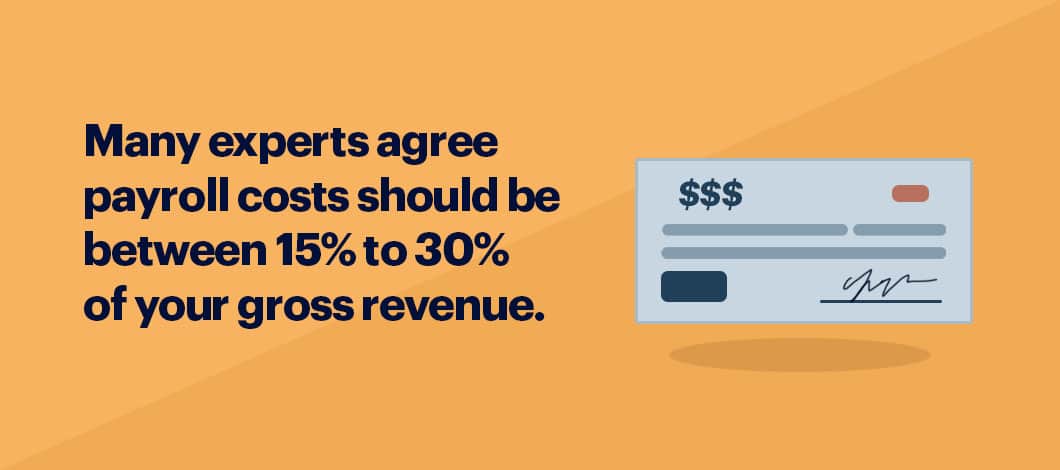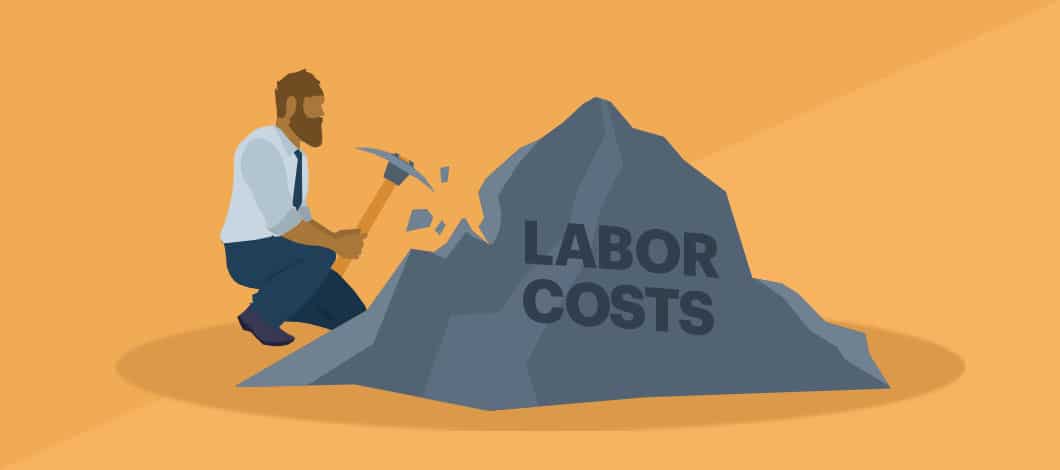Labor costs consume a significant portion of your budget. As such, higher workforce expenses impact your profitability. Here’s how to reduce labor costs and regain peace of mind.
How Do Labor Costs Affect Business?
The National Federation of Independent Business (NFIB) calls labor expenses the “largest operating outlay.” Direct and indirect labor expenses affect the cost of goods sold (COGS), cash flow and profitability.
Direct labor refers to employees who provide services or produce products, whereas indirect labor includes administrative and maintenance staff.
Labor costs for permanent employees are fixed as you pay them regardless of business activity or season. On the other hand, overtime hours, temporary or part-time help and commissions on sales are variable.
If business expenses rise and revenue doesn’t, it could result in a shortfall.
Challenges of Managing Labor Costs
The Economic Policy Institute’s Minimum Wage Tracker shows that in 2022, 25 states will increase the minimum wage because of legislation or annual indexing. At the same time, companies are hiking pay to attract and retain employees.
The NFIB says “seasonally adjusted, a net 44% reported raising compensation” in October and “net 32% plan to raise compensation in the next three months.”
According to the U.S. Bureau of Labor Statistics (BLS), “compensation costs for private industry workers increased 4.1%” from September 2020 to September 2021. In contrast, compensation expenses rose 6.9% “for workers in the leisure and hospitality industry.”
Companies also see higher prices for inventory and utilities. These increases could leave business owners scrambling to make up the difference by raising prices and decreasing labor costs.
According to a survey sponsored by consulting firm North Highland and conducted by The Economist Intelligence Unit, the research and analysis branch of The Economist Group, 67% of respondents said they’re “under pressure to reduce labor expenses.”

What Percentage of Expenses Should Payroll Be?
Average labor costs vary by company size, industry and revenue. There isn’t a set standard, but many experts agree payroll costs should be between 15% to 30% of your gross revenue.
However, labor cost as a percentage of revenue by industry varies. Hospitality businesses such as restaurants face staffing challenges with labor cost rates closer to 35% or as high as 50%.
Payroll expenses reflect the total cost of your workforce and are referred to as the labor burden rate.
Payroll costs include:
- Hourly or salary pay
- Bonuses and commissions
- Paid-time-off (PTO)
- Health insurance
- Fringe benefits
- Federal Insurance Contributions Act (FICA) taxes
- Unemployment insurance
How to Find Your Payroll Percentage
Use a labor cost calculator online or in your payroll software to calculate workforce expenses. You also can measure it manually using a labor cost formula.
Use the following formula to find your payroll percentage:
(Total Payroll Expenses / Gross Revenue) x 100 = Payroll Percentage
Labor Cost Management: How to Reduce Labor Costs in 7 Steps
Workforce expenses increase for many reasons, including a drop in productivity, extra costs for training new employees and scheduling issues.
There isn’t an easy or fast solution for reducing labor costs. Instead, employers should build a workforce management strategy that tackles these expenses from many angles.
1. Increase Visibility of Workforce and Labor Costs
You can’t lower labor costs if your data is inaccurate, incomplete or outdated. Historical and real-time information helps you understand the total costs of labor and the factors that drive it.
Integrated technology systems leverage payroll, attendance and sales data to give a clear view of labor costs and business activities.
Insights include seasonal and hourly trends. You can use this information to make scheduling and hiring decisions, which affect labor expenses.
For instance, many restaurateurs and retailers rely on real-time metrics to decide when to cut or call in workers.
By keeping an eye on these figures and using them in decision-making, you can rein in labor costs and uncover the issues leading to higher expenses.
2. Use Overtime Sparingly and Purposely
In best-case scenarios, you use overtime (OT) when it results in a greater return than the cost. But, many small business owners find themselves relying on OT to cover staffing shortages.
If your use of overtime is increasing or unsustainable, find the root cause by looking at:
- Scheduling: Are scheduling miscalculations contributing to higher labor costs? If shifts go longer on certain days, management should look for ways to reduce other shifts accordingly.
- Staffing: Could adding part-time help or outsourcing tasks help you save on labor costs? Compare your options to see if it makes sense to hire temporary staff or contractors.
- Shift swapping: Are employees picking up shifts that result in overtime? Use scheduling software that prevents staff from switching shifts without manager approval and ensure supervisors understand the financial impact of any changes.
3. Automate and Optimize Systems
Predetermined workflows can reduce human error and allow workers to rely on muscle memory to complete tasks quickly.
Take a good look at the processes your team uses and consider:
- Identifying tasks that can be automated or hastened by technology
- Writing down workflows and highlighting repetitive or unnecessary steps
- Providing self-service tools for employees to save human resource (HR) labor
- Using automation features that come with various technology tools
4. Help Staff Understand and Follow Workflows
The productivity of your team can increase or decrease labor costs. According to The Economist Intelligence Unit, 79% of survey respondents “say they’re under pressure to boost productivity.”
Although automated, optimized systems improve efficiencies, your employees must follow through with the changes. Instead, some workers may revert to old, familiar habits that, unfortunately, waste time.
Let’s say your team adopts a project management tool such as Trello. Employees receive notifications on their devices when someone mentions them, moves a card or assigns a task. Trello also sends email alerts.
Team members may follow workflows for Trello but also send follow-up emails about the topic out of habit.
Employees now need to reply to both the email and the Trello activity. These few extra minutes per day, per team member, can add up to a good chunk of wasted time each week.
Develop a change management strategy to help your crew embrace efficient workflows. Address barriers related to the technology or managing remote employees while pointing out the benefits of the new process.
5. Consider Flexible Work Options and Alternative Roles
In many cases, it costs more money to hire, onboard and train a new worker than it does to keep your existing employee happy.
Moreover, overtime expenses may be reduced by using contingent or part-time workers. The Intuit 2020 Report states “more than 80% of large corporations [are] planning to substantially increase their use of a flexible workforce.”
According to the NFIB, “employment still remains below the 2020 peak, and labor force participation hasn’t responded strongly to the higher levels of compensation,” suggesting that higher wages aren’t the only driver of workplace satisfaction.
Company culture, management and flexibility affect retention, productivity and ultimately, labor costs.
Reduce labor expenses by:
- Job sharing: Replace a full-time role with two part-time positions that share the job duties and hours.
- Flexible labor options: Handle labor surges by hiring temporary or part-time workers or contractors.
- Outsourcing: Pass off noncritical and noncore business tasks to freelancers or third parties specializing in that type of work.
- Remote or hybrid work: Offer flexible work options to employees and track productivity and satisfaction levels to ensure positive results.
6. Invest in Your Employees
According to the NFIB, 10% of survey respondents “cited labor costs as their top business problem,” whereas 24% identified “labor quality” as their biggest concern.
Likewise, Gartner’s survey of HR leaders finds 59% consider “building critical skills and competencies” a priority.
Investing in employees can reduce labor costs by increasing productivity, closing skill gaps and decreasing turnover.
Start by evaluating your talent pool. Ensure you have the right mix of skill sets among your staff and that your workforce is adequately trained.
Next, cross-train employees. The extra coverage helps you avoid overtime or hiring expenses. Lastly, offer career advancement opportunities that can improve employee retention and reduce the costs of hiring, onboarding and training new staff.
7. Improve Scheduling and Time Tracking
Next to your payroll software, your scheduling and time tracking applications are the best tools you can use to reduce labor.
Implement manpower cost control tactics, such as:
- Using scheduling systems that send an alert when an employee nears or goes over 40 hours
- Developing clear policies about clocking in and out for shifts and breaks to prevent time theft
- Running reports that highlight variances in log-in times by shift or worker
- Using attendance systems with geotracking or facial recognition tools to prevent someone else from logging in another employee
Lower Labor Costs With an Effective Strategy
You can reduce expenses and improve productivity by tackling your labor costs from multiple angles. Find the root causes of higher costs and come up with solutions that work for your business and employees.











